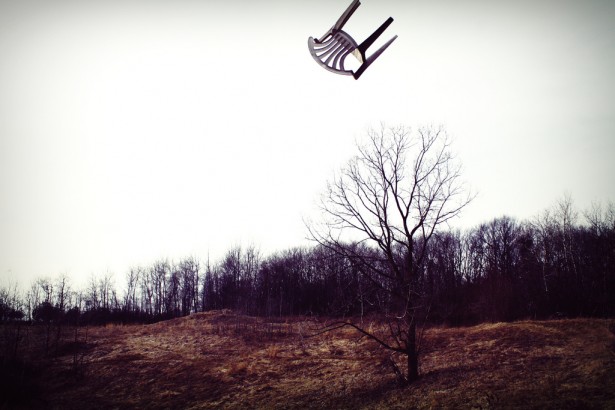This just in: sitting in chairs is lethal.
Yogis already know that sitting leads to tight hips and shortened psoas muscles. Now, a comprehensive new study shows that prolonged sitting doubles your chances of diabetes, heart disease and death.
To come up with this finding, Dr Emma Wilmot, a research fellow in the Diabetes Research Group at the University of Leicester, combined the results of 18 studies, with a total of 794,577 participants.
If you don’t think this applies to you, because you stand on your head every day, or run marathons, here’s the scary part:
“The associations [between sitting and disease] were independent of the amount of moderate-to-vigorous physical activity undertaken, suggesting that even if an individual meets typical physical activity guidelines, their health may still be compromised if they sit for long periods of time throughout the day.”
No wonder, as Andre Picard wrote in the Globe and Mail: “Sitting is the new smoking.”
So how do we butt out if our jobs require us to sit?
Happily, it doesn’t take much.
“Prolonged sitting sharply reduces glucose and insulin secretion, key factors in developing diabetes,” Picard writes. “But these changes can be offset by standing up and walking two minutes for every 20 minutes of sitting.”
(Alert readers of this blog will note that medical science has officially caught up with the Pomodoro technique, invented by computer programmer Francesco Cirillo. He prescribes standing up and moving around for five minutes after every 25 minutes of focused deskwork.)
If you’re going to stand up and move around anyway, why not take a yoga break?
Click on the Five-Minute Yoga Challenge category, or enter Five-Minute Yoga Challenge in the search box at the top right hand corner of the page, and you’ll find 42 suggestions – 43 if you count today’s.
This one is simple, and office friendly – at least if you’re in an office that’s friendly towards taking your shoes off.
It’s also brief. You can easily do two repetitions, go get a glass of water, and be back at your desk in five minutes.
And it takes care of your feet, which is essential if you plan to keep on moving.
Here’s how to stretch your feet on a wood brick:
Set a pair of wood bricks up at the wall, short ends facing out.
Place the sole of your foot, just below the line of the metatarsals, on the edge of the brick and stand on your heels.
You’ll feel an intense stretch in your calves and the backs of your ankles.
At first you’ll need to lean into the wall to keep your balance.
As you become accustomed to the sensation, begin to roll your buttock flesh down towards your heels, and bring your upper body away from the wall.
Look forward, rather than down.
Hold the stretch for 90 seconds, rest, and repeat.
I would never pretend that this is a comfortable stretch. It gets better with practice, but it’s always bracing.
The payoff, however, is huge. You’ll feel it in your first few steps – a light, open, energized feeling that comes from stretching the fascia on the soles of your feet, your Achilles tendons, and your calf muscles.
Besides, coming to terms with the intense stretch also gives you a safe, easily curtailed chance to practice managing discomfort.
Can you be there with your face soft and your breath easy? What’s it like to voluntarily move out of your comfort zone and stay there?
And that said, if it’s excruciating, try stretching one foot at a time. You might find that after the initial stretch, alternating feet, you’re able to move on to stretching both at the same time.
And when you sit down again, remember to set your timer.
Photo courtesy of Nicki Varkevisser, via Flickr
•
Mongolia? Death Valley? The southern tip of South Africa? Yup, those are exotic places to do yoga.
If you’d like to enter the contest to win a set of massage balls, there are still five days left. If you already entered, but the program wouldn’t let you put in the fill in the details, I apologize. This is the first time I’ve used Rafflecopter, and I left a box un-ticked that I should have ticked. It’s fixed now, so please do enter again.



Comments on this entry are closed.
Wow! that is harder than it sounds. I modified it a bit by doing it at my rope wall and holding onto my ropes up high. I will have to work on this.
Hi Claire. Good to hear from you! I think I mentioned it being bracing. . . . maybe that was too weak a word. Doing it at a column that you can hold onto, or in a door, as Terra suggested, also works – only the lucky few have ropes.
Hard as it is, I think it’s close to an essential stretch. You can see the reverberations all the way from standing poses to Malasana.
Hi Eve! Thanks for yet another great tip. I have been toying with the idea of purchasing some wood blocks, and this suggestion may just push me over the edge. One question: on sites that sell wood blocks, there seem to be light wood blocks and heavy wood blocks. I am pretty sure the heavy ones are what I’m using at the Iyengar studio I practice at. Are there any advantages to the light? They are a little less expensive, but I fear they might slip…thanks for any advice you can provide!
Hi Liz,
I’m glad you liked the tip. I have both kinds of wood bricks in my props collection, and much prefer the heavy ones, which are solid cedar. The light ones I have are cedar, but hollow. I don’t know of any advantages to light bricks – they’re not so light that dropping one on your foot is incidental, like dropping a foam brick. Perhaps lighter to carry if you are transporting your props to classes or workshops. I’d bite the bullet and go for the heavy ones.
Thank you, Eve. Heavy blocks it is!! And I”ll try not to drop them on my feet :)
Good plan! People break toes that way.
Hi again, Eve. Any suggestions on where to purchase heavy wood blocks?? I incorrectly assumed that Amazon or an online yoga props store would have them but I’m only seeing light wood blocks! I don’t need light blocks as the studio I go to (in New York City) provides all props. Thank you!
If your studio has heavy bricks, the first thing I’d is ask where they get them. Maybe they have a prop maker they buy from. We get our studio bricks from one of our students who has a business making cabinets. Good luck with the search.
Ok, I will check with my studio. Thanks!
Does not work well with foam bricks as they flip.
I had to put books on them.
Also I couldn’t do it against the wall as my balance isn’t good enough. I had to put them against the wall near a doorway so I could hang on to the door hinge.
And your photo made it look so easy kind of like your gomukhasana photo which had me wondering how does she do that. …. Been practicing it for 3 months and finally it is getting bearable. Not easy just bearable.
Hi Terra,
Good to hear from you! Yes, foam bricks are not really useful for this. Even wood ones will tip up until you get the hang of it.
Good for you for adapting with the doorway – that sounds like it would work well.
As for making it look easy – hey, that’s what yoga teachers are supposed to do. If it’s very hard, just do one foot at a time. It will change over time, and at least you know what’s possible.
Congratulations on your gomukhasana practice! Bearable is good.